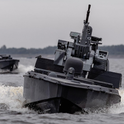On 7th October 1989, the German Democratic Republic celebrated its 40th anniversary. The highlight was the military parade, and East Germany had a formidable military to show off. One year later, the country had ceased to exist and its vast arsenal of weaponry was put in storage or sold off. Now those weapons are being sent to Ukraine. East Germany is rising from the dead to help save at least a few Ukrainian lives.
Under the leadership of Erich Honecker and Defence Minister General Heinz Keßler, the East German National People’s Army was not just a massive military force, comprising well-trained officers and soldiers and an enormous cadre of conscripts, who served between 18 months and three years and were on constant readiness alert. It also possessed a colossal arsenal of Soviet-style weaponry. Because it was beyond dispute which member of the Warsaw Pact was boss, smaller members dutifully bought Soviet-model weapons, which helped the alliance achieve interoperability of a kind Nato’s democracies have long struggled to establish.
When East Germany ceased to exist on 3rd October 1990, the National People’s Army (NVA) left behind 3,000 battle tanks, nearly 8,000 armoured vehicles, countless aircraft, helicopters, howitzers, missiles, 300,000 tons of ammunition and much else besides. Because the Bundeswehr—the West German armed forces which absorbed the East German military—had no use for most of the equipment, it sold or donated much of it to other countries. (The Bundeswehr put other weaponry in storage, used it for parts, or discarded it. There’s even a tank graveyard in the formerly East German town of Rockensußra.
That means that today, lots of countries have old East German equipment. And because the equipment was used by the Soviet Union and other Warsaw Pact states too, it overlaps with what Ukrainian soldiers are used to, cutting out the need for extra training. In January, Estonia wanted to send the Ukrainians ex-NVA howitzers it owned—but the German government blocked the donation. (Berlin has a say in where originally East German weapons end up.) When Russia invaded Ukraine, though, Germany relented. And earlier this month, the Czech Republic, after receiving green light from Berlin, sent 56 ex-East German armoured personnel carriers to Ukraine. Prague also sent the Ukrainians Soviet-model T-72M tanks, some of which have been in Czech possession since its Warsaw Pact days. In this way, former Warsaw Pact countries are extracting revenge on their former occupier and uninvited ruler.
Yes, the Soviet-era equipment is ageing, but when it’s well-maintained it’s dependable. “It was really good to see German government helping us by not blocking the transfer,” Tomáš Kopený, the Czech Republic’s deputy defence minister in charge of industrial production, tells me. “Now I hope they will continue in this line of policy and support Ukraine as much as possible… especially with heavy weapons that will be decisive in the upcoming days.” (The Czechs also sent the Ukrainians new howitzers.)
There’s life yet in the NVA’s remnants. And because countries were at any rate getting ready to retire their Soviet-era equipment, many more NVA weapons should be available for swift transfer to Ukraine in the coming weeks and months.
That’s not to say that countries can simply dispatch hand-me-downs they were going to put out to pasture anyway. Most useful for Ukraine “would be 130mm and 152mm artillery and rockets,” General Richard Barrons, former commander of the UK Joint Forces Command, tells me. “Armoured vehicles are good for general ‘protected mobility’ but most are not suitable at all to mix it with tanks. Ukraine needs more ability to smash up Russian armoured attacks before they close with Ukrainian positions. The problem now is getting them kit and ammunition in time, but if this devolves into a stalemate they will need it anyway.” And saving at least some Ukrainian lives would be a worthy end for East German weapons.
At East Germany’s 40th anniversary celebrations in 1989, the troop inspection was followed by the country’s national anthem. Auferstanden aus Ruinen und der Zukunft zugewandt, begins the first verse: Risen from the ruins and facing the future. Then the NVA proceeded with a parade through East Berlin that displayed the discipline and size of its armed forces, not to mention the extent of its weaponry.
But it was already clear that East Germany had no future. Just over a month later, crowds stormed the Berlin Wall. Honecker, Keßler and the NVA faced defeat not by war but by democracy. Keßler was succeeded as defence minister by a rabble-rousing pastor and conscientious objector named Rainer Eppelmann, whose only job was to take inventory of the NVA’s weapons and personnel and close the organisation down.
Now those weapons are making an unexpected return in Europe’s first land war since the end of Second World War. Former East Germans can be proud that their short-lived country is helping another country face off an invader. Risen from the ruins and facing the future, indeed.












